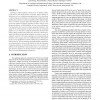Free Online Productivity Tools
i2Speak
i2Symbol
i2OCR
iTex2Img
iWeb2Print
iWeb2Shot
i2Type
iPdf2Split
iPdf2Merge
i2Bopomofo
i2Arabic
i2Style
i2Image
i2PDF
iLatex2Rtf
Sci2ools
VISUALIZATION
2000
IEEE
2000
IEEE
FastSplats: optimized splatting on rectilinear grids
Splatting is widely applied in many areas, including volume, point-based, and image-based rendering. Improvements to splatting, such as eliminating popping and color bleeding, occlusion-based acceleration, post-rendering classification and shading, have all been recently accomplished. These improvements share a common need for efficient framebuffer accesses. We present an optimized software splatting package, using a newly designed primitive, called FastSplat, to scan-convert footprints. Our approach does not use texture mapping hardware, but supports the whole pipeline in memory. In such an integrated pipeline, we are then able to study the optimization strategies and address image quality issues. While this research is meant for a study of the inherent trade-off of splatting, our renderer, purley in software, achieves 3 to 5 times speedups over a top-end texture hardware (for opaque data sets) implementation. We further propose a way of efficient occlusion culling using a summed are...
Efficient Framebuffer Accesses | Software Splatting Package | Texture Mapping Hardware | Visualization | VISUALIZATION 2000 |
| Added | 01 Aug 2010 |
| Updated | 01 Aug 2010 |
| Type | Conference |
| Year | 2000 |
| Where | VISUALIZATION |
| Authors | Jian Huang, Roger Crawfis, Naeem Shareef, Klaus Mueller |
Comments (0)

